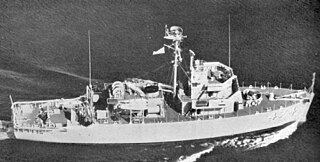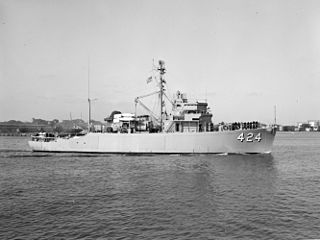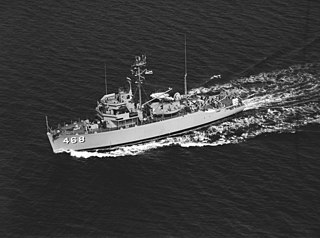USS Pigeon (AM-374) was an Auk-class minesweeper acquired by the United States Navy for the dangerous task of removing mines from minefields laid in the water to prevent ships from passing.

USS Tanager (AM-385) was an Auk-class minesweeper acquired by the United States Navy for the dangerous task of removing mines from minefields laid in the water to prevent ships from passing.
USS Wheatear (AM-390) was an Auk-class minesweeper acquired by the United States Navy for the dangerous task of removing mines from minefields laid in the water to prevent ships from passing.

USS Vital (AM-474/MSO-474) was an Agile-class minesweeper in service with the United States Navy from 1955 to 1972. She was sold for scrap in 1979.

USS Staff (AM-114) was an Auk-class minesweeper acquired by the United States Navy for the dangerous task of removing mines from minefields laid in the water to prevent ships from passing.

USS Bold (MSO-424) was an Agile-class minesweeper acquired by the U.S. Navy for the task of clearing mines that had been placed in the water to prevent the safe passage of ships.

USS Redwing (AMS/MSC-200) was a Bluebird-class minesweeper in the United States Navy.

USS Valor (AM-472/MSO-472) was an Agile-class minesweeper in service with the United States Navy from 1954 to 1970. She was sold for scrap in 1971.

USS Bluebird (AMS/MSC-121) was a Bluebird-class minesweeper acquired by the US Navy for clearing minefields in coastal waterways.

USS Agile (MSO-421) was an Agile-class minesweeper acquired by the U.S. Navy for the dangerous task of removing mines from minefields laid in the water to prevent ships from passing.

USS Avenge (MSO-423) was an Agile-class minesweeper acquired by the U.S. Navy for the task of clearing mines that had been placed in the water to prevent the safe passage of ships.

USS Dominant (MSO-431) was an Agile-class minesweeper built for the United States Navy.

USS Nimble (AM-459/MSO-459) was an Agile-class minesweeper in service with the United States Navy from 1955 to 1970. She was sold for scrap in 1981.

USS Notable (AM-460/MSO-460) was an Aggressive-class minesweeper acquired by the U.S. Navy for the task of removing mines that had been placed in the water to prevent the safe passage of ships.

USS Rival (AM-468/MSO-468) was an Agile-class minesweeper acquired by the U.S. Navy for the task of removing mines that had been placed in the water to prevent the safe passage of ships.
USS Stalwart (AM-493/MSO-493) was an Aggressive-class minesweeper acquired by the U.S. Navy for the task of removing mines that had been placed in the water to prevent the safe passage of ships.
USS Sturdy (AM-494/MSO-494) was an Aggressive-class minesweeper acquired by the United States Navy for the task of removing mines that had been placed in the water to prevent the safe passage of ships.

USS Venture (AM-496/MSO-496) was an Aggressive-class minesweeper acquired by the U.S. Navy for the task of removing mines that had been placed in the water to prevent the safe passage of ships.

USS Assurance (AM-521/MSO-521) was an Ability-class minesweeper acquired by the U.S. Navy for the task of removing mines that had been placed in the water to prevent the safe passage of ships.
Operation Dew refers to two separate field trials conducted by the United States in the 1950s. The tests were designed to study the behavior of aerosol-released biological agents.















